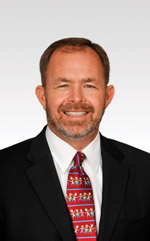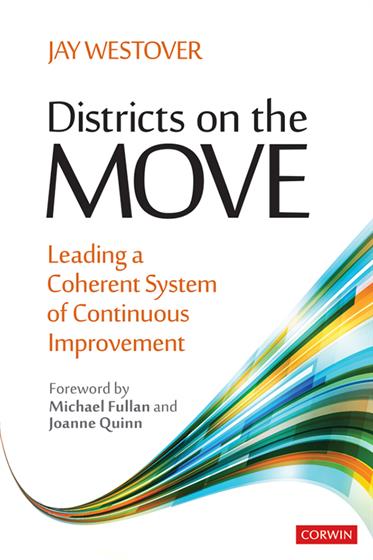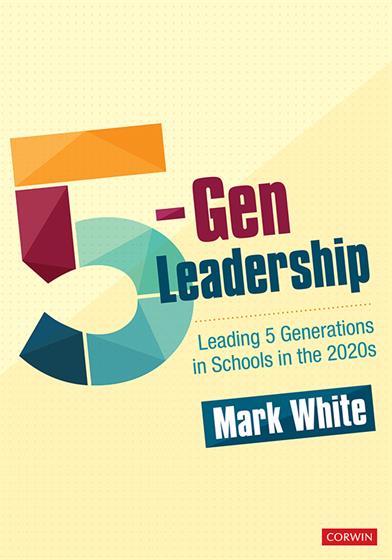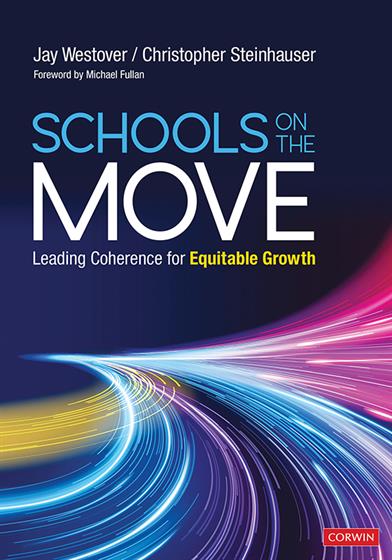Series 3 Leaders Coaching Leaders Podcast
[00:00:00.00] [MUSIC PLAYING]
[00:00:00.85] MODERATOR: Welcome to Corwin's Leaders Coaching Leaders
podcast with host Peter DeWitt. This podcast is from education leaders for
education leaders. Every week, Peter and our guests get together to share
ideas, put research into practice, and ensure every student is learning not by
chance, but by design.
[00:00:19.36] TANYA GHANS: Hey, Peter. Welcome back to another episode of
Leaders Coaching Leaders.
[00:00:23.47] PETER DEWITT: Hey. It's good to see you too, Tanya.
[00:00:25.63] TANYA GHANS: Yeah. So before this episode as I was thinking
about the guest we were having on today, I had to take-- I had a real moment of
awe when I thought about what it takes to lead a district or a system that has
tens of thousands of students in it. And what an awesome responsibility that
is. And how important it is for leaders who are embarking on that work to hear
from people who have done it successfully. So that's something that made me
really excited about the guests that are going to be on our show today.
[00:01:01.01] PETER DEWITT: Yeah. So we have Chris Steinhauser who was-- he
was the superintendent of Long Beach Unified School district for 19 years, and
they have 70-- over 70,000 students. And yeah, that is a little mind blowing
when you think about that. And then we have Jay Westover who is also his
co-author, but he's the co-founder and chief learning officer for innovative
Ed. And they have this book schools on the move. And this conversation-- excuse
me, it's not only about the book--
[00:01:36.24] I mean, I think that's important to be able to talk about what
does your book offer, but it was also just some really practical insight into
not only how school leaders and teachers should be doing work or should be
operating, but it was really about also acknowledging the high level of burnout
that people are feeling, and the idea of, how do you get people to be a part of
a school team when they're burned out and they don't want to take out anymore
and you've got principals that are losing teachers and they've got unfilled
positions? And we got into that stuff because I feel like it's important for us
to be real with those conversations. And Chris and Jay certainly did a really
good job of answering those questions.
[00:02:19.02] TANYA GHANS: Yeah, I completely agree. So without further ado,
listeners, enjoy the session.
[00:02:26.34] PETER DEWITT: Hey, Chris and Jay. Welcome to the Leaders
Coaching Leaders podcast.
[00:02:31.60] JAY WESTOVER: Thanks.
[00:02:32.27] CHRIS STEINHAUSER: Thank you. Appreciate the opportunity.
[00:02:34.25] PETER DEWITT: Absolutely. It's good to see you both.
Congratulations on the book, Schools on the Move. Chris, can you talk to me a
little bit about where that came from?
[00:02:42.91] CHRIS STEINHAUSER: Well, it actually came from Jay. So during
the COVID 19 pandemic, I had just retired. Jay contacted me because I've known
him for a long, long time and asked if I would be interested in writing this
book with him documenting some of the work that we did in Long Beach that he's
done.
[00:02:59.74] PETER DEWITT: So Jay, give me some give me some follow up on
that since it came directly from you.
[00:03:05.35] JAY WESTOVER: I think Chris is being a little bit too kind. So
Long Beach is recognized as probably one of the most successful districts we
know in the United States, and I've always appreciated what he's done as a
superintendent. So we understood school improvement, district improvements. But
Chris coming on board and writing the book really added a lot of layers to it,
because it went from, we know how to do this work to, here's how this work
actually looks like in action. So I don't think the book would have been what
it is now if it wasn't for Chris and the work in Long Beach.
[00:03:41.35] PETER DEWITT: Well, I'm glad that-- I mean, you're both still
talking after the book, so that's--
[00:03:45.67] CHRIS STEINHAUSER: Yeah.
[00:03:45.97] PETER DEWITT: --a good thing. So that's nice. I think you
raise a good point, Jay. And Chris, I want to talk to you a little bit about
that because you're up-- one of the issues is, people will read a book and say,
well, how are we supposed to do this? And that's something that you're
offering. And I don't want to make this question just about the book either.
[00:04:05.05] I actually want to make it about the fact that over the past
couple of years, when we work with school leaders or teachers, they're looking
at it, but they're just saying, how do we do this back at our school? So can
you give some examples about what you focused on just so people know the topics
that you were looking at and what to do about it? So just a couple of examples
of what you focused on the book.
[00:04:29.43] CHRIS STEINHAUSER: Yeah. So the work the-- writing the book
was a great experience because it really helped to bring for me the experience
that we had over the last 20 plus years in Long Beach developing a coherent
system. And you're always have new stakeholders, new kids, new teachers, new
parents. And so it's really important to focus on those key drivers of having a
clarity of focus, continuous improvement, shared leadership, and what does that
mean?
[00:04:55.48] What does it mean to lead from the middle? What does it mean
when you say what is good and what does it look like? And it's an ongoing
process. And I think that's one of the things that leaders-- a lot of people
want easy fixes, and there is no easy fix in our system. But when you develop a
system that focuses on all of those key drivers and really takes leading from
the middle seriously and looking at data and communicating and accountability,
it's so rewarding to see what can happen.
[00:05:24.84] PETER DEWITT: Yeah. So in this podcast, this is season 3, and
one of the things that Tanya and I have really tried to do for this season is
develop more of a common language and a common understanding because I think
sometimes we drop words in education, and we make an assumption that everybody
knows what the words mean.
[00:05:44.89] So when you say shared leadership-- and maybe I'll go to Jay
with this one because Chris, you called him the brains of the operation. So
Jay, I'm going to go to you on this one. When we talk about shared leadership,
could you talk a little bit about what that means because I think that's
something that might mean different things to different people?
[00:06:03.78] JAY WESTOVER: Yeah. I think the way we approach it is, you can
say from a layered aspect. We know what a school system-- that district team,
whether it be a cabinet or extended cabinet has to really have a collective
understanding of the improvement process, how they engage the schools. But then
a lot of times, that relationship between the principal and the school district
is not tethered enough or strong enough.
[00:06:28.86] So there's got to be that shared leadership between those
district leaders and principals so they see they're moving not only their
school but the system forward. Then the principal has to develop an
exceptionally strong school leadership team, more distributed leadership and structure,
and ultimately, it has to impact teacher teams or PLCs. So we've always thought
of it as like a ladder.
[00:06:49.35] You go from the student to the PLC or teacher team to the
school leadership team to the principals up to the district. And when we say
shared leadership, we look across the whole system. And a lot of times, we'll
try to identify where there's a fraying or there's not a strong enough
collaborative learning or co-leading co-learning stance.
[00:07:11.09] So the book was really written to say all schools should be on
the move, but the system has to be positioned from a shared leadership
standpoint so that all schools can be successful and they can't be in
isolation.
[00:07:23.98] PETER DEWITT: So Chris, you have-- I mean, you have a lot of
experience. Your bios is huge, and you've been in education for a long time.
Superintendent. If I read correctly, your school district was over 70,000
students, right?
[00:07:36.58] CHRIS STEINHAUSER: Right.
[00:07:38.05] PETER DEWITT: So right now, one of the things that I think
school leaders are having an issue with besides actually finding teachers to
hire-- sometimes when you're working in schools, you're having a very difficult
time filling positions. But it almost seems-- it's also, it doesn't seem, it
really is, that teachers are exhausted there's a high level of burnout on the
part of teachers and school leaders.
[00:08:01.06] So how do you get somebody-- how do you suggest to school
leaders some ways to get people to be a part of a team when teachers are just
saying no mas. No more, we're burned out.
[00:08:16.19] CHRIS STEINHAUSER: That's a great question. I'm working with a
school system right now that-- and it's a great system. They were doing great
things before COVID. And, of course, then COVID hit, and it paralyzed them a
little bit to be really honest with you. So how do you step back into that deep
end of the pool? And we start learning rounds.
[00:08:34.41] And so we actually-- and this was a great system where they
wanted to do it, but they were apprehensive. And so what they actually did is,
teachers led the first charge. So we help teachers understand what a learning
round was about, look at their problems of practice, but they didn't include
their administrator. And I have to give the administrator credit because they
had to provide the structure and culture there to let it go forward.
[00:08:57.35] This particular school now, every single staff member-- and
there's about 20 of them, have either been a host or an observer and a learning
round. They've done about four of them. But it's that supporting them, leading
from the middle. And they've seen unbelievable movement in student achievement
in a very short period of time, but it's just providing those structures and
that support there to be that coach on the side, so to speak.
[00:09:20.72] PETER DEWITT: Yeah, I like what you're saying there too
because once again, back to the common language and common understanding, when
you talk about the whole staff understanding learning rounds, that's a key
element that not everybody does. I mean, I've worked with principals I want to
engage in walkthroughs, but they've never worked with their staff on what
walkthroughs are or what to look for when they're doing walkthroughs.
[00:09:39.23] One of the issues, Jay, that actually-- it's always been
around, let's face it, but it's something that really came to the surface
during COVID was that of equity and student equity issues. So how does your
work in this book in particular help educators overcome that prevailing student
equity issue?
[00:10:01.76] JAY WESTOVER: I think our work has always been focused on-- we
just usually call it a school implementation plan. So if you can imagine, we
ask schools to author one page. They have to have a clear focus with priorities
that has equity at the forefront, and then they have to talk about student
success indicators, instructional strategies, how they'll use collaboration
productively, how they'll actively assess learning, and then we ask them to do
that in a six week inquiry cycle. So I think most schools will understand
there's an equity issue, but they very rarely unwrap that and peel the onion.
[00:10:42.12] So the work that we've always done and promoted is, you have
to peel back the layers, but the layers require you to do inquiry cycles. And
every time you complete one, you learned something new. So I agree with you,
Peter, that equity sometimes is just a buzz word that we try to make equity
become more of a continuous improvement collaborative inquiry driven cycle
where they discover the equity issues through their work and then they are
hopefully empowered to attend to them in a productive manner.
[00:11:16.94] PETER DEWITT: Yeah. I was listening to a researcher author
Yemi [? Stonebridge ?] the other day, and he was talking about equity. And I
thought that was a pretty good term. I wanted to make sure I gave him credit
for at least using that word. What can school district leaders do now to
navigate a coherent path of progress for sustainable improvement? Chris, I know
you were talking about coherence before.
[00:11:43.76] CHRIS STEINHAUSER: Yeah. I'll give you a great example. I'm
working with a big high school here in Southern California, and the system
itself put in a policy that no F could be lower than 50%. I mean, that's huge.
And that part-- that came out of the pandemic. But as you can imagine, policies
don't always get down into every classroom and so on.
[00:12:03.23] So through the collaborative process that Jay was explaining,
this particular high school with their school leadership team, they were really
struggling with coherence and enlightenment. So we actually did student empathy
interviews. And it came from the students that said, if you are truly about
equity, then why isn't that not everyone gives common assessments or allows
retakes or the grading?
[00:12:26.96] So this particular school has then come up with three
non-negotiables for next year that they're all going to do, everyone will give
a retake and you can get at least a B or better, everyone will have common
assessments, and they're going to have great common grading criteria. That's
huge, huge, but that came through this process of collaboration, listening to
student voice, and about the inequities that they experience.
[00:12:48.80] PETER DEWITT: Yeah, it's nice. I'm glad you mentioned empathy
interviews. I see that as a growing trend. It reminds me-- I know Russell
Bishop in Australia does a lot of work on empathy-- he doesn't call them
empathy interviews, but with marginalized populations. And I see that actually
finally is a trend that's coming through the United States and it intersects
with Russ Cooley's work on student voice as well.
[00:13:12.90] And I just think that's-- it's so excellent, and yet at the
same time it's common sense. So it's a little sad that we're like, hey, let's
talk to the students about what they're learning and all that stuff. Jay, I
want to ask you a question. I know that Chris was giving you a lot of credit
where all this is concerned. But from an educational standpoint and from
something listeners want to be able to understand too, what was the greatest
lesson, you learned from Chris when you started to work with him?
[00:13:52.94] JAY WESTOVER: Leadership matters. And when you look at Chris
as a superintendent, he's a type of superintendent who was extremely involved
in his work. [AUDIO OUT] didn't get in the way. And [AUDIO OUT] highly engaged
in the work and not get in the way of the work. And he was an equity warrior.
So what I learned from Chris is that you have to really be intentional and
focused on equity, and you have to empower and help people be successful.
[00:14:29.74] But you have to be extremely involved so you're knowing where
things are going and you know how to provide support and resources at a
minute's notice. And I just recognize it from the principle level up that
people don't get that push pull right most of the time, and Chris was very
balanced, I thought, in his approach. So I wish we had more superintendents
like him.
[00:14:55.41] PETER DEWITT: Chris, let me ask you a question. What is the
hardest part you see-- because you have all this experience and you're doing
this work in schools and everything else, what is the barrier you see to
actually doing this work that you're suggesting?
[00:15:14.15] CHRIS STEINHAUSER: That's a great question because I served 18
years as a superintendent and 39 in the system, and obviously many jobs in
between. And I think sometimes people want easy fixes. They want the shiny
apple tomorrow, and there's a lot of pushes out there. So for example, from the
boards, from your community, from your business people.
[00:15:36.54] And it takes a lot of work for people to understand that
this-- you've got to go slow to go fast and you have to celebrate those wins
along the way. And in developing that culture that everyone's going to work
together for this great outcome. And sometimes people don't want to put their
energy in that because there's a lot of energy upfront that you've got to put
in to get those outcomes.
[00:16:00.91] And you may not see some gains for the first year or two
years, but you've got to stick with it. But if you believe in continuous
improvement, that's the beauty of looking at data. Both hard data, soft data, I
call it street data from the kids and so on. But it's amazing what can be
achieved once you put it together and have faith.
[00:16:18.67] PETER DEWITT: Yeah, I like that street data. It's a really
good thing to be able to say. What is it you want people to walk away
understanding about your book? Like what's a key takeaway, Jay, that you want
people-- when they're reading the book and when they're doing this work, what's
the key takeaway that you want them to have?
[00:16:41.50] JAY WESTOVER: Yeah. I think I'll go from a very simple answer,
Peter. So Chris mentioned in the beginning, we believe that collaborative
inquiry is the core driver of the work. We have to deeply understand how that's
a process for co-leading and co-learning and what it looks like and how to
engage in it.
[00:16:59.77] But then clarity of focus is essential. We have to know where
we're going, how we're going to get there. We have to have that shared
leadership in place that's going to be effective and productive. From a
structural standpoint, we have to understand pedagogy, we have to understand
instructional coherence, and then we have to understand those cycles of
improvement.
[00:17:18.20] So I think the book was written to engage the school level and
really understanding where they are now and where they have to build strength,
and also a tool for district leaders to look across all their schools,
understand systemically where there might be an issue that they have caused,
but then also look at individual schools to figure out how to best support
them. So we try to do a balance of, all schools should be on the move, but yet
a district should be more capable of understanding the improvement of systems
and the support of individual school sites at the same time.
[00:17:54.97] PETER DEWITT: One of the things that you focused on is another
one of those tricky words that we hear in the field from people, and that's the
whole idea of continuous improvement. Why do you think that continuous improvement
sometimes gets a bad rap? I'll take either one of you that might have an answer
there.
[00:18:12.43] JAY WESTOVER: So Chris, if you can answer that from how you
did that inquiry process--
[00:18:17.35] CHRIS STEINHAUSER: Yeah. I'm laughing because I'll use me as
an example because we have been doing it for so many years. I had some teachers
finally come up to me and say, Chris, can't we just stop? And so I use the
analogy, I said, if you remodel your house and you start painting your rooms,
you eventually go back to the first room you're painted. I go, because it's old
and it just needs to be refreshed.
[00:18:41.83] It's the same thing with us. So we have a new group of kids
that come in every year. In some cases, some districts have a lot of new
teachers, so we have to bring everybody on there. And there's new research.
There's new powerful things out there. I mean, your student voice-- I didn't
use a lot of student voice in the beginning of my career and I and I regret
that.
[00:18:59.38] I always wondered, what we could be at today if we had done
that. And so the issue is, continuous improvement is like a diet. You're always
wanting-- you have a workout plan. You want to get better. You want to get
stronger. You're looking at that data and then when you share that with people,
they go, I get it. Because people always want to say, is it done? And I go, it's
not done until every single kid is where we want he or she to be.
[00:19:22.63] PETER DEWITT: Yeah. That's a really good analogy. So I
appreciate that. And I think we all who have been in education for a long time,
I think we always look back and wish we did some things differently. And I
think that we're trying to-- especially during the pandemic, trying to find a
more human way to operate as well as a school. I mean, things we should have
been doing, but we don't. So this might seem like an odd question as we start
to wrap this up, but it's going to be, what question do you wish I asked that I
didn't in this podcast? I'd like to-- what question do you wish I asked, Jay,
that I didn't?
[00:19:58.03] JAY WESTOVER: Well, I'm just going to extend what you asked
Chris. We usually call that improvement cycle just 369. And so what I've
noticed is, everyone will talk about PLCs but I don't usually see a very strong
3 to 4 week inquiry cycle that has impact every 3 to 4 weeks.
[00:20:17.98] And that I don't see a school leadership team that understands
how they're moving the school and about every six weeks, they should be
checking in on grade level content teams, how we improving as a school? How do
we adjust? And then I don't always see principals coming together every 9 to 12
weeks and saying, how's my school doing and how are all schools doing in
conversation with the system leaders?
[00:20:42.70] So I think the question that we try to answer is, how do you
put a continuous improvement process in place that really engages strong
feedback loops at the teacher teams, school leadership team, principal district
leader level so the system knows where it's going and knows where to attend to
problems of practice at any given time. I think the challenge may not be we
don't understand continuous improvements, it might be that we just have never
done it well. It's probably what the real problem is.
[00:21:18.33] PETER DEWITT: Yeah, that's definitely a great suggestion. I
think sometimes district offices-- respectfully, but I think sometimes district
offices contradict the work that they want the buildings to do. I find that
there's a disconnect between what they want building leaders to do with their
school leadership teams. And the message that's given from the district when
building principals go up to district meetings, we don't model what we're
actually preaching for them to do. Chris, what about you? What's a question
that you wish that I asked that I didn't?
[00:21:51.66] CHRIS STEINHAUSER: Well, I'm going to build upon what both of
you just said because the question is, how do we build structures and culture
to do exactly what we're talking about? Because you're right. Sometimes systems
aren't supporting the work that needed to be done. And Jay's exactly right that
we have to have these structures in place. So how do we build them within the
times that we have and how do we re-imagine what we do?
[00:22:13.77] And more importantly, how do we help every educator to
understand that he or she is a leader, and that they can lead from the middle,
and that they can-- if they use these tools, I mean, they're lifelong and
they're going to have a huge impact for the positive and closing the gap. I
think that's our greatest challenge. How do we massive the forces together for
the good?
[00:22:35.70] PETER DEWITT: Well, gentlemen, thank you very much, Chris
Steinhauser, Jay Westover, the book is Schools on the Move from Corwin, and
thank you so much for being on the Leaders Coaching Leaders podcast.
[00:22:47.01] CHRIS STEINHAUSER: Thank you.
[00:22:47.97] JAY WESTOVER: Thanks, Peter. I appreciate the opportunity.
[00:22:50.23] [MUSIC PLAYING]
[00:22:53.63] So Tanya, what do you think? What do you think about the
interview? Did I do OK?
[00:22:57.37] TANYA GHANS: [LAUGHS] You did OK, Peter, I guess. Now, as
always, what a way that we-- like we keep it in this very friendly and open and
safe discussion, but gives so much information in a small piece-- in a small
span of time. And one of the things that I took away from that, again-- because
there's always so much I take away from these conversations that you have with
our guests, but we have this thread in all of our sessions about defining the
terms because it's really important that people have a common language when they're
talking about things.
[00:23:33.22] PETER DEWITT: Yeah.
[00:23:33.87] TANYA GHANS: And so in this session, really thinking about
alignment and continuous improvement and just making sure there's coherence in
the system, all of those terms that revolve around this idea of people
collaborating around a shared vision, how that just becomes more and more and
more important the larger and larger and larger the district is and the more
people you have to bring together to do this.
[00:23:58.57] And that it is absolutely vital that you have systems in place
that can keep the system moving so that, as the author said, as new people are
coming in and coming out, you have structures in place to get people
on-boarded, if you will. Because what it means if that's not in place at the
end of the day is that children will fall through the cracks. Students will
lose. And so I really liked how they talked about the importance of just the
glue and the collaboration and its impact on our ultimate goal of student well-being
and achievement.
[00:24:37.72] PETER DEWITT: Yeah. And I asked-- I'm glad this season, what
we're trying to do is just asking about that common language and common
understanding. That's been a bug of mine for four years when we talk about
student engagement or growth mindset. And so when Chris mentioned conti-- or
when Jay mentioned continuous improvement, I wanted to really ask what does
that mean? They had a great follow up answer, which I think is important.
[00:25:05.39] I know that off air, we had a good conversation too, which
was, why is it that potential school leaders are not learning these things,
these important details in their University training? When we're going back to
be in school leaders and we go through the school leadership classes and law
and education and everything else, why are we learning these practical things
either?
[00:25:32.53] And I feel like Jay and Chris definitely are offering some
tools for people who are new to their position but also experienced in their
position that they may not have gotten when they were doing their actual
original University training. So I think that's important too because it's
really practical, it's based in research, and just overall, it was a good
conversation.
[00:25:58.96] I do like that Chris mentioned street data. That, to me, was
just a really nice thing. And I'm glad that he mentioned empathy interviews too
because like I said during the podcast, I feel like empathy interviews are on a
serious trend. And they're just so important because they're hearing from
students and students are talking about what the barriers are to learning. And
yeah, it does-- it reminds me of Russ Cooley's work on student voice that he's
been doing for so long. So just really important elements that schools-- that
school leaders and teachers can look to as well. So no I enjoyed the
conversation very much.
[00:26:33.31] Yeah Yeah. I mean, hopefully our sessions do act like a course
syllabi or something--
[00:26:39.66] [LAUGHTER]
[00:26:40.87] Where our own little school doing our best to at least
introduce listeners to topics that, again, are evidence based, research based,
people who have done the work and done it well. And so always excited to learn
with you. And--
[00:26:58.12] PETER DEWITT: Yeah. Maybe we can ta-- maybe we can now call it
Ghans DeWitt University or something.
[00:27:02.62] [LAUGHTER]
[00:27:03.76] TANYA GHANS: We have to figure out how to get accreditation.
[00:27:06.10] PETER DEWITT: There you go.
[00:27:06.76] TANYA GHANS: [LAUGHS] Peter--
[00:27:08.23] PETER DEWITT: Well, Tanya, always good to see you.
[00:27:10.30] TANYA GHANS: Always good to see you too, Peter. Enjoy the rest
of your day.
[00:27:13.33] PETER DEWITT: You as well.
[00:27:14.05] [MUSIC PLAYING]










